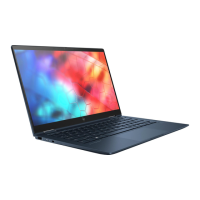
Do you have a question about the HP Elite Dragonfly Max and is the answer not in the manual?
| Storage | Up to 2 TB PCIe NVMe SSD |
|---|---|
| Graphics | Intel Iris Xe Graphics |
| Processor | Intel Core i5-1135G7 or i7-1185G7 |
| Display | 1920 x 1080 |
| RAM | Up to 32GB LPDDR4x |
| Operating System | Windows 10 Pro |
| Weight | Starting at 2.49 lb (1.13 kg) |
| Battery | 4-cell, 56 Wh Li-ion polymer |
| Camera | IR camera |
| Audio | Bang & Olufsen |
| Dimensions | 1.61 cm |
| Ports | 1 x HDMI 2.0, 1 x headphone/mic combo |
| Wireless | Intel Wi-Fi 6 AX201 (2x2) and Bluetooth 5 combo |
| Security | HP Sure Sense, HP Sure Click, HP Sure Start |
Detailed listing of computer hardware components and their specifications.
Description of various ports like HDMI, USB, and audio jacks.
Information on security features like TPM and fingerprint sensors.
Identification of components on the right side of the computer.
Identification of components on the left side of the computer.
Description of display-related components and features like privacy screen.
Details about the keyboard, touchpad, and associated controls.
Explanation of various status lights on the computer.
Locating and identifying speakers and the fingerprint reader.
Explanation of function keys and embedded numeric keypad.
Identification of components on the top, bottom, and rear of the computer.
Information on locating and understanding service labels for identification.
Instructions for inserting a SIM card and using the Tile feature.
Illustrated catalog of primary replaceable computer parts.
Details of components included in the cable kits for various models.
Listing and identification of various miscellaneous computer parts.
Essential tools, service precautions, and handling guidelines before disassembly.
Critical information and methods to prevent static damage to components.
Recommended procedures for cleaning computer surfaces and using disinfectants.
Guidelines for safely packaging and transporting computer hardware.
Methods and locations for finding HP support and technical information.
Introduction to component removal and replacement procedures.
Step-by-step guide to remove the bottom cover and battery.
Procedures for replacing solid-state drives and WWAN modules.
Instructions for replacing heat sinks, fans, cables, and various boards.
Guidance on removing and replacing the display assembly and top cover.
Methods for backing up data and creating recovery media.
Procedures for restoring the system using various methods and media.
How to modify the computer's boot sequence for recovery.
Using HP Sure Recover for OS restoration without recovery media.
Navigating and configuring system settings via the BIOS.
Steps for determining and installing BIOS updates.
Configuring Trusted Platform Module (TPM) settings for enhanced security.
Information on HP Sure Start for BIOS protection and recovery.
Running hardware diagnostics within the Windows operating system.
Performing hardware diagnostics outside the OS using UEFI.
Using remote diagnostics features for system health checks.
Detailed technical specifications for the computer's hardware.
Technical details related to the computer's display panel.
Technical specifications for the available solid-state drive options.
Procedures to restore nonvolatile memory to factory settings.
Table of nonvolatile memory types and troubleshooting steps.
FAQ addressing BIOS, UEFI, and memory-related queries.
General power cord requirements applicable globally.
Country-specific power cord requirements and certifications.